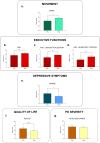Physical activity based on dance movements as complementary therapy for Parkinson's disease: Effects on movement, executive functions, depressive symptoms, and quality of life
- PMID: 36730266
- PMCID: PMC9894447
- DOI: 10.1371/journal.pone.0281204
Physical activity based on dance movements as complementary therapy for Parkinson's disease: Effects on movement, executive functions, depressive symptoms, and quality of life
Abstract
Background: Parkinson's disease (PD) is a progressive, neurodegenerative disease with motor symptoms that are well understood, but non-motor symptoms may be present and appear at different temporal stages of the disease. Physical activity based on dance movements is emerging as a complementary therapeutic approach to a range of PD symptoms as a multidimensional activity that requires rhythmic synchronization and more neuromuscular functions.
Objective: To evaluate the effects of physical activity based on dance movements on the movement, executive functions, depressive symptoms, quality of life, and severity of PD in individuals diagnosed with PD.
Methods: 13 individuals with PD (Hoehn & Yahr I-III, MDS-UPDRS 67.62 ± 20.83), underwent physical activity based on dance movements (2x week for 6 months). Participants were assessed at baseline and after 6 months on movement (POMA, TUG and MDS-UPDRS Part III), executive function (FAB), depressive symptoms (MADRS), quality of life (PDQ-39), and severity of PD (MDS-UPDRS TOTAL). Student's t-test was used to compare pre and post-intervention results.
Results: We observed a significant improvement in the movement (balance and gait) by the POMA test, p = 0.0207, executive function by the FAB test, p = 0.0074, abstract reasoning and inhibitory control by the FAB, Conceptualization test, p = 0.0062, and Inhibitory Control, p = 0.0064, depressive symptoms assessed by the MADRS test significantly reduced, p = 0.0214, and the quality of life by the PDQ-39 had a significant increase after the intervention, p = 0.0006, showed significant improvements between the pre-and post-intervention periods of physical activity based on dance movements.
Conclusion: Physical activity based on dance movements contributed to significant improvements in movement (balance and gait), executive functions, especially in cognitive flexibility and inhibitory control, and the quality of life too. Sensorimotor integration, most cognitive processing and social skills may have contributed to the results.
Trial registration: The study was registered in the Brazilian registry of clinical trials: RBR-3bhbrb5.
Copyright: © 2023 Duarte et al. This is an open access article distributed under the terms of the Creative Commons Attribution License, which permits unrestricted use, distribution, and reproduction in any medium, provided the original author and source are credited.
Conflict of interest statement
The authors have declared that no competing interests exist.
Figures


References
Publication types
MeSH terms
Substances
Associated data
LinkOut - more resources
Full Text Sources
Medical
Research Materials
Miscellaneous

